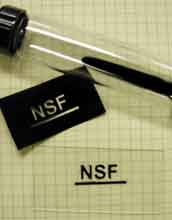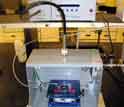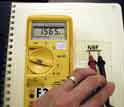News Release 04-047
New Molecule Heralds Breakthrough in Electronic Plastics
New material could mean easier manufacture of paper-thin TVs and "smart" cloth

An organic solution of Oligotron mixed with chemicals that help the material set under light.
April 12, 2004
This material is available primarily for archival purposes. Telephone numbers or other contact information may be out of date; please see current contact information at media contacts.
ARLINGTON, Va.—Researchers have developed a new plastic that conducts electricity, may be simpler to manufacture than industry counterparts and easily accommodates chemical attachments to create new materials.
Developed by TDA Research in Wheat Ridge, Colo., Oligotron polymers are made of tiny bits of material that possess a conducting center and two, non-conducting end pieces. The end pieces allow the plastic bits to dissolve in solvents and accommodate specialized molecules.
For decades, researchers have been trying to craft electronics that use plastics instead of metal to transmit currents. In addition to the potential savings in weight and cost, conducting polymers could be manufactured in a variety of convenient shapes, yielding such innovations as fabrics that transmit data and incredibly thin video displays.
However, because conducting polymers initially were not soluble in liquids, they could not be manufactured as easily as could their common counterparts used in soda bottles and synthetic fibers. Recent discoveries resulted in a water-soluble conducting polymer called PEDOT (polyethylenedioxythiophene), yet water can corrode device parts during manufacturing and shorten the lifespan of the end product.
Oligotron, developed with National Science Foundation (NSF) Small Business Innovation Research (SBIR) support, contains a PEDOT center, but it is soluble in non-corrosive chemicals and can attach new compounds to its end pieces, adding a variety of functions. For example, researchers have proposed end pieces that convert solar energy into electricity, ultimately creating a novel solar cell material.
Oligotron also has special properties that allow the material to be "printed" into various device shapes. When technicians shine a pattern of ultraviolet light, such as a complex circuit image, onto a film of dissolved Oligotron, the exposed areas of plastic become "fixed" like a photograph. Flexible and lightweight, the circuit is also fully functional.
TDA researchers predict applications for the product that range from flexible television displays and smart cards to antistatic treatments and conducting fabrics.
Oligotron is a trademark of TDA Research, Inc.
Comments from the researchers:
"Through our research we discovered that by attaching molecules to the ends of the PEDOT, the chemical could easily disperse in organic solvents, something we have not seen with typical conducting polymers."– Brian Elliott, Senior Chemical Engineer, TDA Research, Inc.
"When we added photo-sensitive end groups to the Oligotron we created a material that could be printed using an ultraviolet light source. Using a patterned light source resulted in a patterned image that could conduct electricity." – Brian Elliott, Senior Chemical Engineer, TDA Research, Inc.
"We began this research with the goal of developing easier methods to manufacture electronic devices with conducting polymers. We wanted to solve the problems related to the difficulties of dispersing conducting polymers in non-corrosive, organic solvents and create an easy method to print detailed features." – Brian Elliott, Senior Chemical Engineer, TDA Research, Inc.
"We were surprised to discover that the Oligotron could conduct electricity almost as well as the completely non-dispersible, pure form of the PEDOT polymer." – Brian Elliott, Senior Chemical Engineer, TDA Research, Inc.
"The reactive chemical groups on the ends of the Oligotron molecules will allow other scientists to synthesize new molecules, building additional functionality onto the molecule. These molecules will allow chemists to use their creativity to invent new materials with conducting polymers." – Brian Elliott, Senior Chemical Engineer, TDA Research, Inc.
NSF comments regarding the discovery:
"Flat-panel displays are probably the largest market for organic electronic materials. The development of soluble polymers could have a large impact on the cost and ease of processing these displays." – Winslow Sargeant, the NSF program officer who oversees TDA's award.
"This is a significant breakthrough: a soluble and highly conductive multi-block copolymer, with its ability to be photo-crosslinked, could lead to a printable conducting polymer with a high conductivity." – Winslow Sargeant.
-NSF-
-
The ultraviolet-light spot-curing apparatus used to photoprint the conducting polymers.
Credit and Larger Version -
Demonstrating the conductivity of the photoprinted "NSF" image.
Credit and Larger Version
Related NSF Item:
NSF Workshop Highlights Future of Organic Electronics and Photonics
http://www.nsf.gov/od/lpa/news/03/ma0303.htm
Principal Investigator: Dr. Brian J. Elliott, TDA Research (303) 940-2341 belliott@tda.com
The SBIR/STTR Programs stimulate technological innovation in the private sector, by strengthening the role of small business concerns in meeting Federal research and development needs, increasing the commercial application of federally supported research results, and fostering and encouraging participation by socially and economically disadvantaged persons and women-owned small businesses. NSF awards SBIR grants to small businesses for risky, novel research with a potential for commercialization. Through SBIR and the related Small Business Technology Transfer (STTR) programs, NSF encourages partnerships between the small business and the academic sectors to develop a technology base for commercialization.
Media Contacts
Josh Chamot, NSF, (703) 292-7730, email: jchamot@nsf.gov
Program Contacts
Winslow Sargeant, NSF, (703) 292-7313, email: wsargean@nsf.gov
The U.S. National Science Foundation propels the nation forward by advancing fundamental research in all fields of science and engineering. NSF supports research and people by providing facilities, instruments and funding to support their ingenuity and sustain the U.S. as a global leader in research and innovation. With a fiscal year 2023 budget of $9.5 billion, NSF funds reach all 50 states through grants to nearly 2,000 colleges, universities and institutions. Each year, NSF receives more than 40,000 competitive proposals and makes about 11,000 new awards. Those awards include support for cooperative research with industry, Arctic and Antarctic research and operations, and U.S. participation in international scientific efforts.
Connect with us online
NSF website: nsf.gov
NSF News: nsf.gov/news
For News Media: nsf.gov/news/newsroom
Statistics: nsf.gov/statistics/
Awards database: nsf.gov/awardsearch/
Follow us on social
Twitter: twitter.com/NSF
Facebook: facebook.com/US.NSF
Instagram: instagram.com/nsfgov




